Near Tokyo! 6 Famous Hot Spring Areas in Gunma

Gunma boasts splendid hot spring resorts that are easy to access from Tokyo by bus and train. Each hot spring area has traditional inns offering a truly Japanese experience. Today we feature hot springs from famous spots all the way to little-known hideaways.
Gunma: A Hot Spring Paradise Near Tokyo
When you're feeling tired there's nothing better than taking a relaxing dip in a soothing hot spring. But many people living in the greater Tokyo area mistakenly think that there are no naturally sourced hot springs nearby.
With that in mind, we'd like to recommend hot springs in Gunma Prefecture that are easily accessible, even from Tokyo. These include the famous Kusatsu Onsen, Shima Onsen, and Ikaho Onsen.
Read also
The Three Famous Hot Spring Resorts in Gunma
Gunma Prefecture is home to many hot springs―from onsen areas familiar to everyone all the way to little-known hidden spots. The mineral content of the spring water differs from place to place, and some spots are also famous for their spa treatments.
There are also well-established ryokan that have been in business for many years. So we recommend staying overnight to refresh your body and mind.
One of Gunma's attractive features is the many hot springs that can also be enjoyed on a day trip, including Gunma Hot Springs Yasuragi-no-Yu.
Next, we feature Gunma's onsen in detail including famous places and lesser-known hideaway spots.
1. Kusatsu Hot Springs

Photo by Pixta
Kusatsu Onsen was selected as one of Japan's Top Three Onsen, along with Hyogo Prefecture's Arima Onsen and Gifu Prefecture's Gero Onsen.
The highlight here is Yubatake, a spot in the center of the hot spring resort where 4,000 liters of spring water come gushing out every minute. This area is lined with wooden barrels that collect sulphur, the main component of hot spring water. These mineral deposits are sold as a natural bath salt called Kusatsu Yunohana.
Kusatsu Onsen had already been discovered as early as the Kamakura Period (1185-1333), and has been famous as a spot for therapeutic spa treatments (toji) since before the Edo Period (1603-1868).
Even today, the spring waters that are used for medical treatment are extremely acidic. They are said to be effective for skin-related conditions (ie. atopic dermatitis, psoriasis vulgaris, epidermolysis), as well as diabetes.
Official website: Kusatsu Onsen
2. Ikaho Onsen
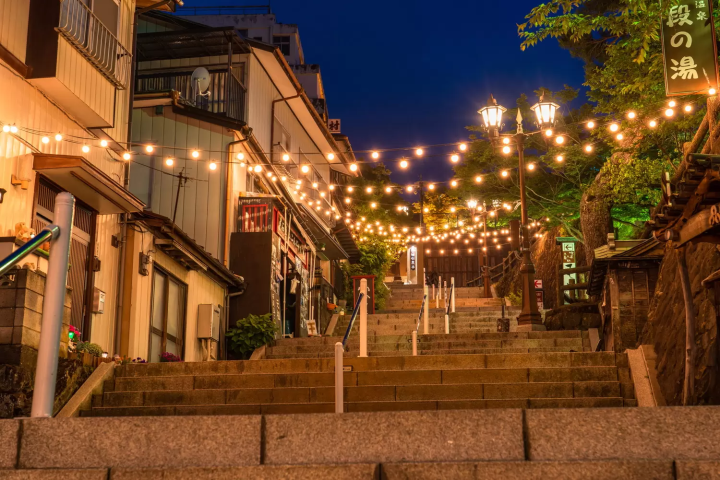
Photo by Pixta
Ikaho Onsen is a hot spring town located partway up Mt. Haruna at an altitude of about 700 meters.
Through the years it's been loved by tanka poets and great writers alike. The nearby area is very attractive and features a flight of stairs with 365 stone steps, and slightly beyond, a charming retro townscape.
The town offers two kinds of hot spring water: a cloudy water known as Kogane-no-Yu, and a colorless, transparent water called Shirogane-no-Yu. These are sulfate springs. It's a gentle spring, and because it warms the body from the inside out, it's also known as a fertility bath (Kodakara-no-Yu).
Official website: Ikaho Onsen
3. Shima Onsen
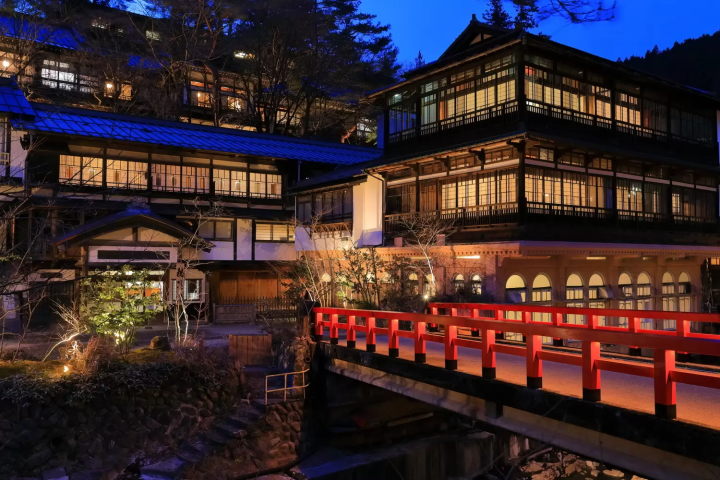
Photo by Pixta
Shima Onsen or Forty-Thousand Hot Springs, got its name because its waters can apparently cure some 40,000 illnesses. The water is said to be good for your stomach and intestinal tract so you can try drinking some at one of the nearby water fountains.
Visitors here can enjoy soaking in a variety of baths, including communal baths and foot baths (ashi-yu) that are also suitable for day trips. The springs are sulphate springs and sodium-calcium-chloride springs, which are said to be effective for neuralgia and skin disorders.
This hot spring area is located along the Shimagawa River in Joshin'etsukogen National Park. Visitors can take in the impressive natural surroundings such as the nearby gorge and the cobalt blue waters of Lake Shima.
Official website: Shima Onsen
Read also
Top 3 Hideaway Hot Springs in Gunma
If you ever find yourself getting tired of the same old onsen tours, we recommend searching for some little-known hidden spots. These are also close to the greater Tokyo area, so if you love hot springs please try visiting some of them.
Oigami Onsen
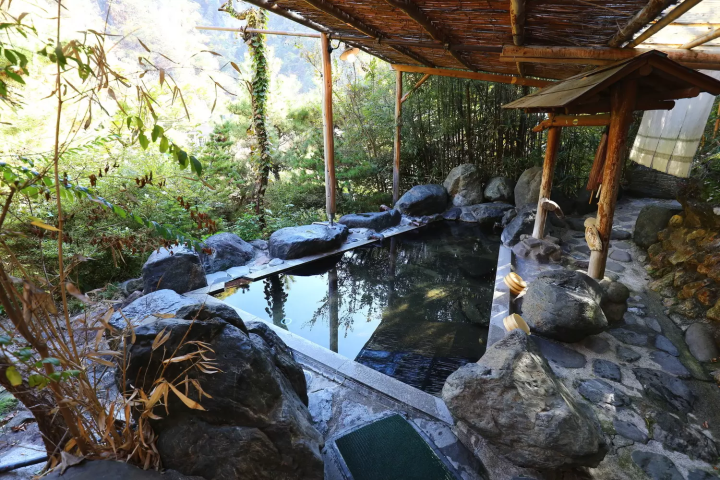
Photo by Pixta
Oigami Onsen was first discovered by the god of Mt. Akagi according to legend.
The god of Mt. Akagi was said to have healed his wounds in the hot spring after driving away the god of Mt. Futara. The onsen then came to be called Oigami (one meaning of the word is the god that drove someone away). Every May the Daija Festival is held to honor this story.
Though this hot spring area is on the smaller side, there are several ryokan nearby and it features many types of hot spring water. It's mainly a simple spring which is said to be good for boils (skin eruptions) and swelling.
In addition to this, there are also simple alkaline springs and simple sulphuric springs, so you can choose your ryokan based on the kind of springs they offer.
Official website: Oigami Onsen
Takaragawa Onsen

Photo by Pixta
Takaragawa Onsen is located along the Takaragawa River in Minakami Town, Gunma Prefecture's northernmost point.
It features four open-air baths (rotemburo) that are some of the largest in Japan. Of these, three are communal mixed-gender baths (both men and women) and one is for women only.
The local area also served as the location for the Japanese movie, "Thermae Romae."
Visitors here can enjoy the elegant scenery and hot springs. One of the baths is Kodakara-no-Yu, an open-air bath that is 200 tatami mats (about 3,558 square feet) in size, and can accommodate close to 200 bathers.
However, please keep in mind that the hot springs here are only available to guests of the ryokan, Osenkaku. Day trippers have access to the hot springs at Takaragawa Sanso.
For details on Osenkaku, please also have a look at the upcoming section in this article, Accommodation Facilities For Enjoying Gunma's Hot Springs.
Official website: Takaragawa Onsen
Hoshi Onsen
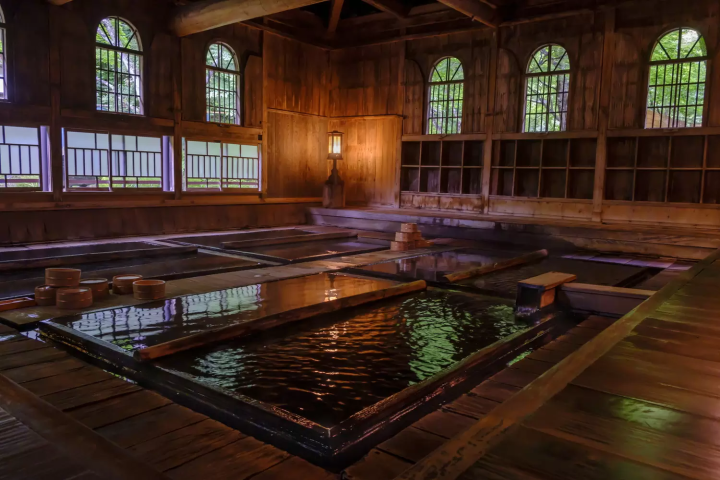
Photo by Pixta
These springs were apparently discovered by an influential Japanese monk, Kobo Daishi, during a junshaku (*1) pilgrimage, and later given the name Hoshi Onsen (*2).
There are three different baths: Hoshi-no-Yu, Tamaki-no-Yu, and Choju-no-Yu. Hoshi-no-Yu and Choju-no-Yu are both mixed-gender baths (Note: Hoshi-no-Yu is for women only from 20:00 to 22:00)
Each bath has its own unique feel. In particular, the bottom of Hoshi-no-Yu's bathtub has been inlaid with cobblestones, between which the spring waters naturally flow out.
This is a famous onsen that was even loved by great writers. This is essentially a calcium-sodium sulfide spring and is said to be good for burns, stomach and intestinal disorders, and arteriosclerosis.
For details on Hoshi-no-Yu (Hoshi Hot Springs Chojukan) please see the upcoming section, Accommodation Facilities For Enjoying Gunma's Hot Springs.
Official website: Hoshi Onsen
*1 Junshaku: a cane embellished with a tin ring that was carried by monks such as Kobo Daishi who traveled around the country spreading the teachings of Buddha.
*2 Hoshi Onsen: one kanji character from Kobo and one kanji character from Daishi were combined to form the name, Hoshi.
Enjoy Gunma's Hot Springs at a Traditional Inn
Many people who visit a hot spring area will want to spend some leisurely time at a ryokan or hotel. Next, we introduce our recommended accommodation facilities in the various hot spring towns.
Kusatsu Onsen: Mukashigokoro no Yado Kanemidori
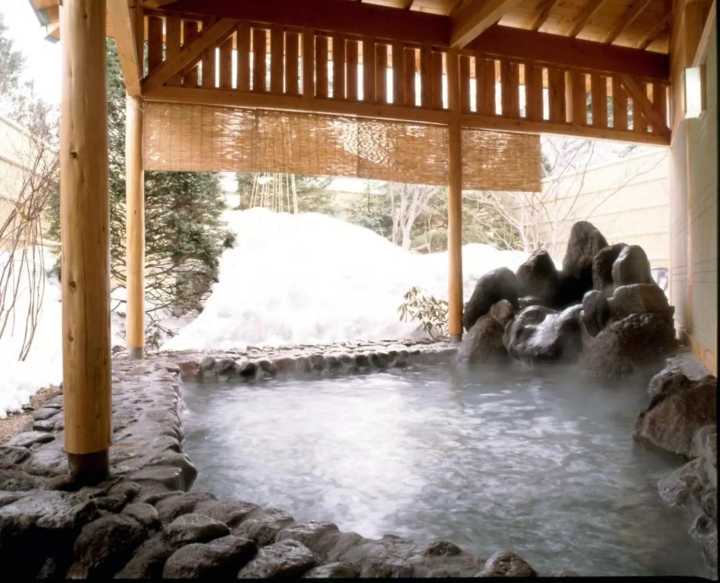
Picture courtesy of Booking.com
Mukashigokoro no Yado Kanemidori is a Japanese-style ryokan that was established in 1902. It's conveniently located just three minutes on foot from Yubatake, or hot springs field, where the waters of Kusatsu Hot Springs come gushing out.
The guest rooms have also been designed with a Japanese feel. Some rooms only have tatami mats, while others are Japanese-Western-style rooms with wood flooring.
There are two baths here: the large communal bath that's sourced directly by Yubatake, and the private open-air bath that's sourced by Bandaiko Hot Springs. Though each has a different source, they are both highly acidic, and are effective for various disorders including skin conditions.
In addition, on the premises of Kanemidori you'll also find two restaurants and a remote work space with free Wi-Fi. Here visitors can enjoy a Japanese-style banquet dinner.
Kanemidori
Access: About 30 minutes by bus from Naganohara-Kusatsuguchi Station. About five minutes on foot from the Kusatsu Onsen Bus Terminal. A complimentary shuttle bus operates between the Kusatsu Onsen Bus Terminal and Kanemidori.
Location: Gunma, Agatsuma, Kusatsu, Kusatsu 162
Check-in / Check-out: 15:00 - 19:00 / 8:00 - 10:00
Ikaho Onsen: Nagomigokoro no Yado Omori

Picture courtesy of Booking.com
Nagomigokoro no Yado Omori is a long-established ryokan with a 100 year history.
The restaurant has adopted the concept of local food production and consumption, so diners here can enjoy creative banquet-style cuisine using locally sourced ingredients.
The hot springs feature a large communal bath, a private open-air bath, and a rooftop open-air bath. At the rooftop open-air bath, guests can enjoy a great view from 800 meters above ground while sipping on their favorite alcoholic beverage (For health reasons, each guest is restricted to one drink).
At Ikaho Onsen there are two kinds of spring waters, Kogane-no-Yu and Shirogane-no-Yu. But here at the ryokan they use Shirogane-no-Yu. These waters are gentle on the skin and are effective for treating fatigue.
Omori
Access: About 20 minutes by bus from Shibukawa Station
Location: Gunma, Shibukawa, Ikaho, Ikaho 58
Check-in / Check-out: 15:00 - 18:00 / 10:00
Shima Onsen: Sekizenkan Kashotei Sanso
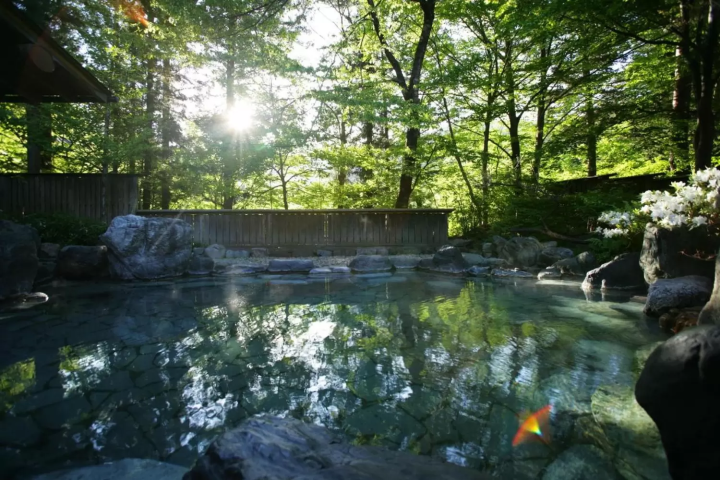
Picture courtesy of Booking.com
Sekizenkan Kashotei Sanso was founded in 1694 and is a long-standing ryokan boasting a history exceeding 300 years.
The ryokan presently consists of three buildings: the Honkan building, Kashotei building, and Sanso building. Guest rooms in the Kashotei and Sanso buildings feature an atmosphere that combines the Showa Era (1926-1989) with a present-day modern feel.
The Honkan, in addition to acting as a model for the bathhouse in the popular Ghibli film, "Spirited Away," was designated a National Registered Tangible Cultural Property.
Genroku-no-Yu is ideal for visitors on a day trip. Then ryokan guests can enjoy the private bath (reservations are free) at Sanso-no-Yu, the indoor bath and open-air bath at Mori-no-Yu, and the two private baths, Sumi and Zen (paid reservations).
Mori-no-Yu is particularly attractive because you can soak in the soothing spring waters surrounded by fresh green foliage.
The ryokan has been loved since ancient times for its therapeutic spa treatments. So in addition to accommodation, it's also a place for rest and recuperation, where physical and mental ailments are treated with spring water and healthy food.
Sekizenkan
Access: About 40 minutes from Nakanojo Station.
Location: Gunma, Nakanojo, Shima Ko 4236
Check-in / Check-out: 15:00 - 18:00 / 11:00
Oigami Onsen: Ginshotei Awashima
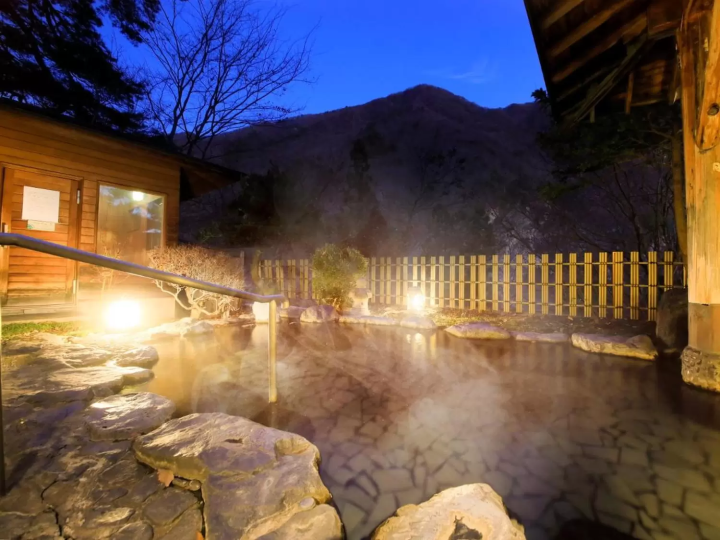
Picture courtesy of Booking.com
Ginshotei Awashima is a ryokan overlooking the Oigami Gorge, where you can enjoy famous hot springs surrounded by majestic nature.
Oigami Onsen's source is a simple sulphur spring and simple spring. The water is soft and is known for its skin-beautifying effects.
Guests can enjoy the fresh green foliage at the large bath, or go for a relaxing dip in the private bath with a view. Some guest rooms also come with their own open-air bath.
The dining space is a private Japanese-style room that's ideal for a leisurely dinner or breakfast. The restaurant utilizes the concept of local food production and consumption, so diners can savor tasty dishes that make use of the bounty from the nearby mountains.
Ginshotei Awashima
Access: A complimentary shuttle bus is available from both Jomo-Kogen Station and Numata Station.
Location: Gunma, Numata, Tonemachi, Oigami Onsen 603
Check-in / Check-out: 15:00 - 19:00 / 10:00
Takaragawa Onsen: Osenkaku

Picture courtesy of Booking.com
Osenkaku is a ryokan where visitors can fully enjoy the four different open-air baths (one is for women only) at Takaragawa Hot Springs.
The open-air baths are comprised of Maka-no-Yu (mixed gender bathing and women-only bathing), Hannya-no-Yu, Kodakara-no-Yu, and Maya-no-Yu. All the baths can be enjoyed amidst the beautiful natural surroundings.
Guest rooms are found in the Main Hall (Honkan), East Building (Higashikan), and Annex #1 (Daiichi Bekkan). The newest of these is the East Building which was built in 1966 and then renovated in 1999. Each of the Japanese-style rooms have their own unique charm which is further enhanced by the fresh greenery seen from the windows.
Osenkaku
Access: About 30 minutes by bus from Minakami Station. A complimentary shuttle bus (reservations required) is available from Jomo-Kogen Station and Minakami Station.
Location: Gunma, Tonegun, Minakami, Fujiwara 1899
Check-in / Check-out: 14:00 - 19:00 / 8:00 - 10:00
Hoshi Onsen: Hoshi Onsen Chojukan
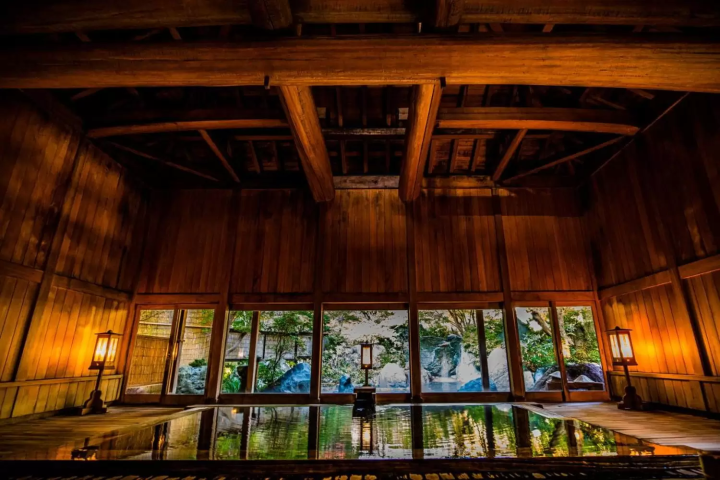
Picture courtesy of Booking.com
Hoshi Onsen Chojukan is a stand-alone inn that has been in operation since the Meiji Period (1868-1912). For more than six generations the same family has manged this long-established ryokan.
The ryokan consists of four buildings: the Main Building (Honkan), the Annex, Kunzanso, and Horyuden. The Main Building was built in the early part of the Meiji Period and was also designated as a National Registered Tangible Cultural Property. The atrium in the Main Building is a spectacular sight.
Horyuden, rebuilt in 1988, is the newest of the four buildings. The other buildings date back to the Showa Period. Each building has its own unique atmosphere and gives off the feeling of a secret hot spring resort.
Hoshi Onsen Chojukan
Access: About 30 minutes by bus from Jomo-Kogen Station to Sarugakyo Station. Then about 20 minutes from Sarugakyo Station to the ryokan.
Location: Gunma, Tonegun, Minakami, Nagai 650
Check-in / Check-out: 15:00 - 18:00 / 8:00 - 10:30
Gunma's Hidden Hot Springs and Recommended Inns
Gunma Prefecture, home to many active volcanoes, has many hot spring areas. There are hot springs famous throughout Japan all the way to secret hot springs that are said to be gems. They are all close to the greater Tokyo area and have convenient access.
While it's also possible to visit these spots on a day trip, staying overnight in a long-established traditional ryokan is a great way to have a fully satisfying trip.
On your next visit to Gunma Prefecture be sure to experience the charm and appeal of its many hot springs!
Read also
Written by Kakutama editorial team












![[Gero Onsen Suimeikan] Just an hour and a half from Nagoya! Enjoy the famous hot springs and delicious Hida cuisine at this long-established inn!](https://resources.matcha-jp.com/resize/200x2000/2024/01/31-164647.webp)































![[Coupon Available] Attention Overseas Winter Sports Fans! Nagano's Sports Depot Has Evolved](https://resources.matcha-jp.com/resize/720x2000/2026/01/05-254819.webp)
![[2 hours from Tokyo ] 10 Quiet and Breathtaking Views of Mount Fuji in Yamanashi Hokuto City , Yamanashi - Part 2](https://resources.matcha-jp.com/resize/720x2000/2025/12/16-253037.webp)
